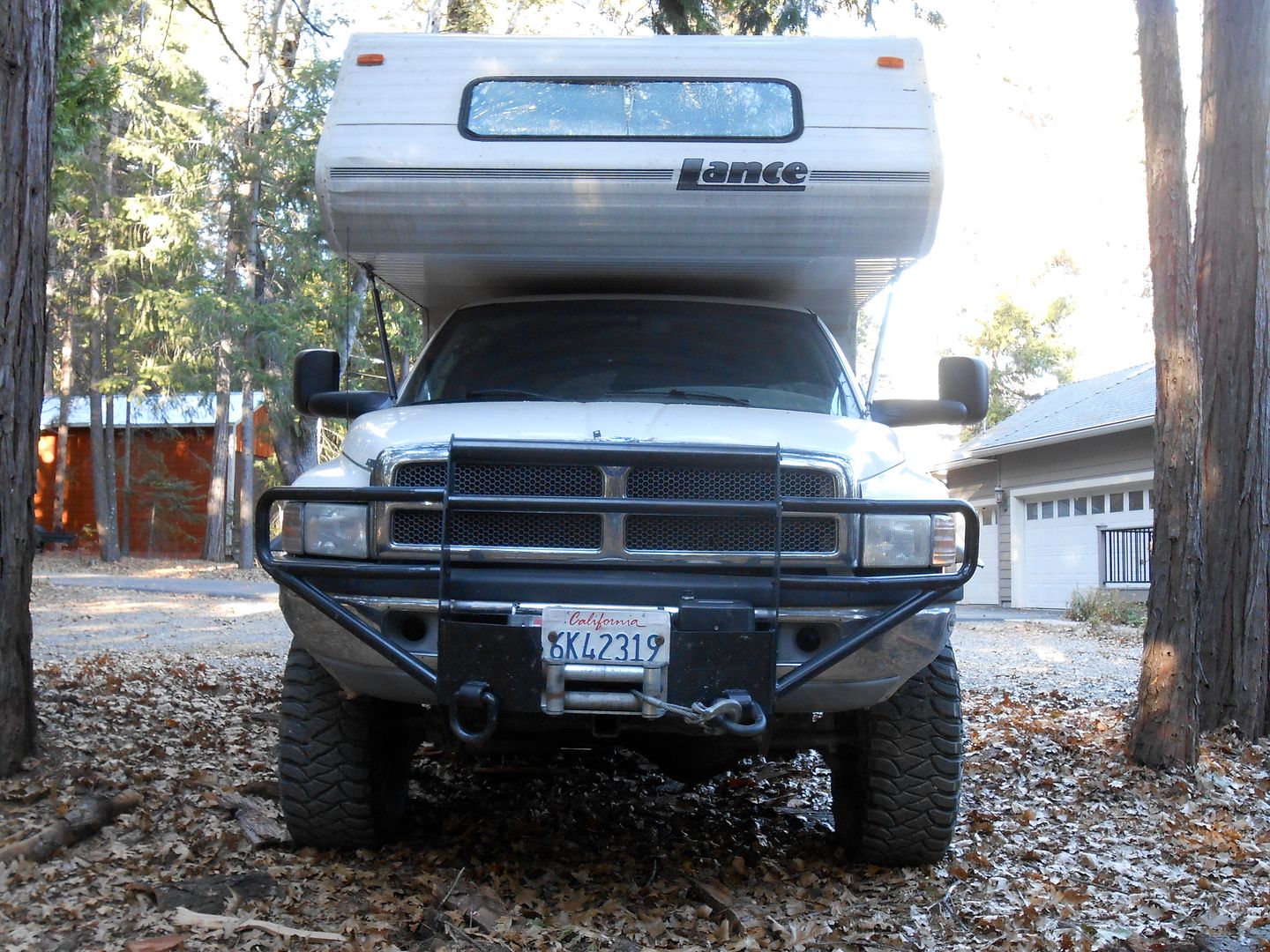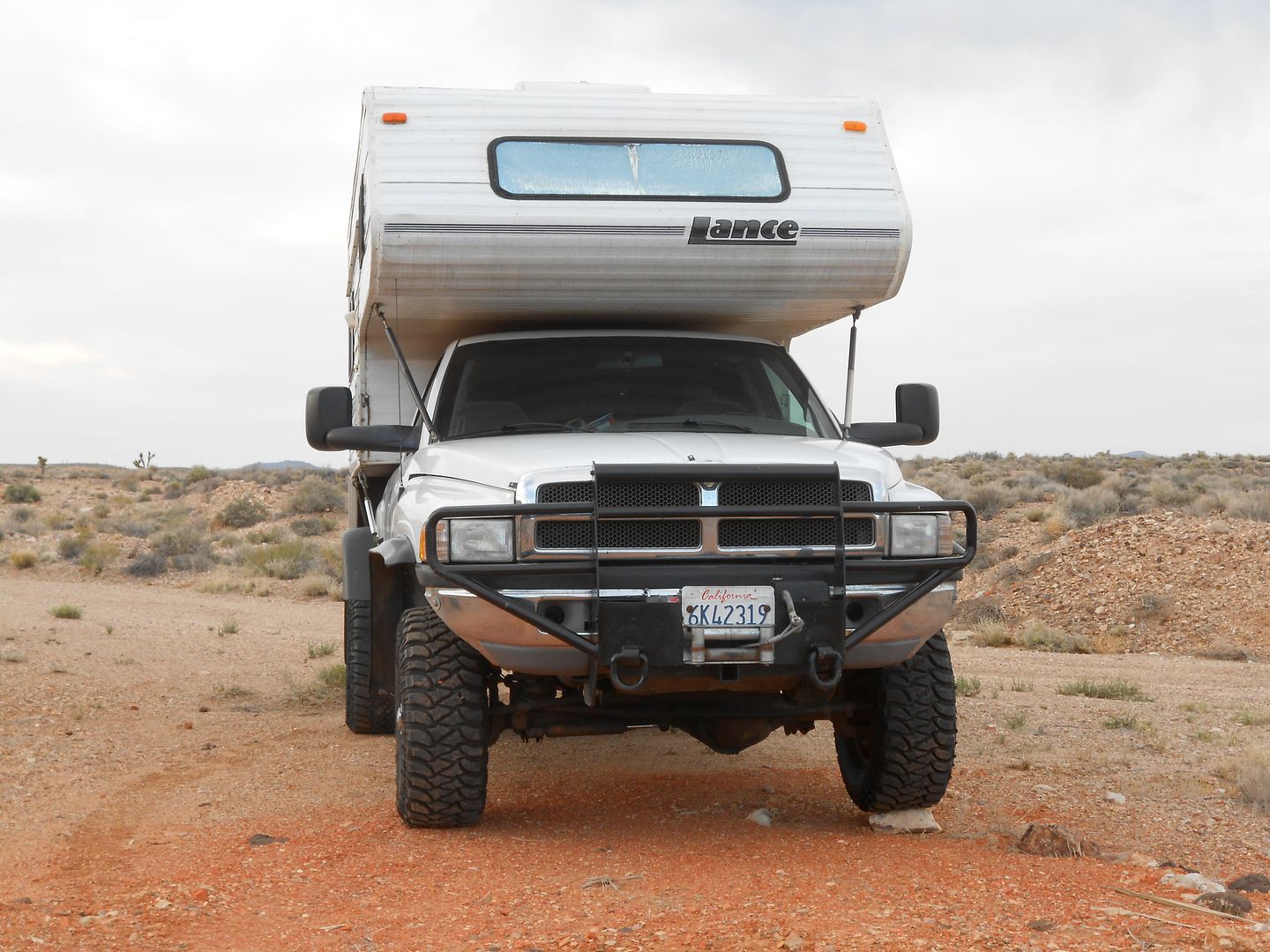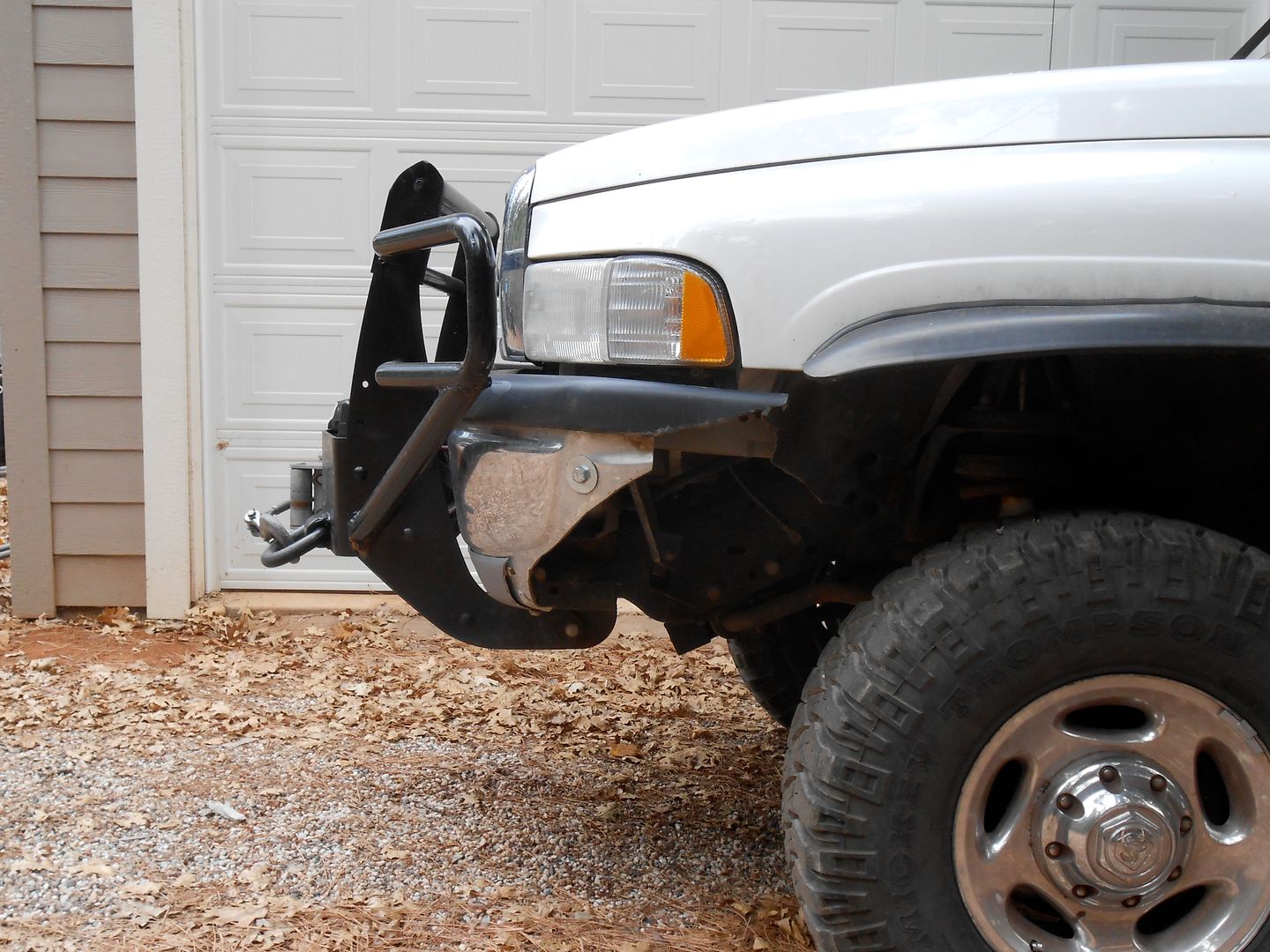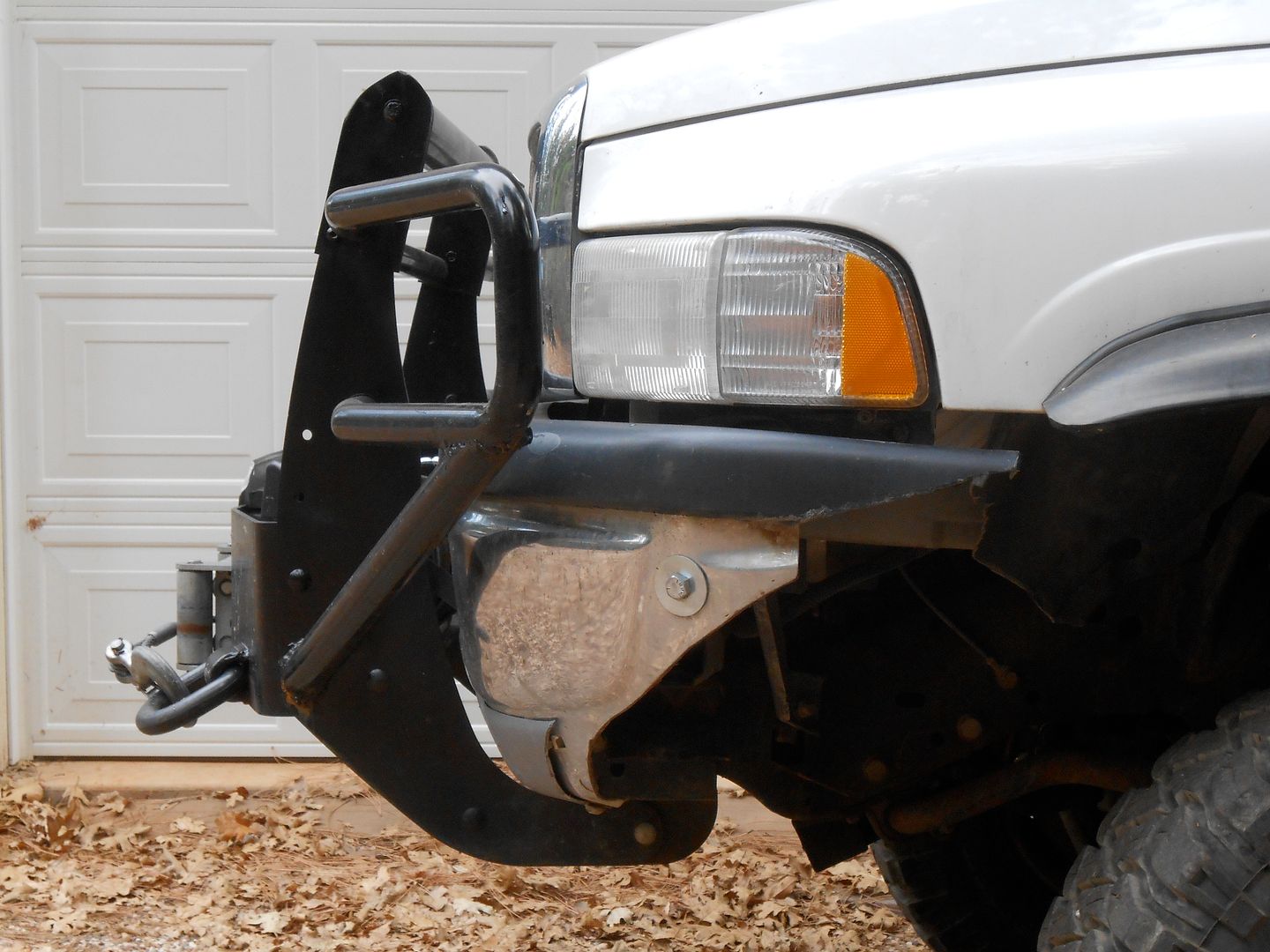Mundo4x4Casa
West slope, N. Ser. Nev.
It's obvious that there are many approaches to bumpers as there are many requirements for use. I drew my personal line on the bumper by only having as much as I need according to my experience (in about 2 million miles in 14 four wheel drives). Currently I have an '82 CJ8 rockcrawler, a '99 XJ winter car, a '11 Jeep Cherokee, and my '01Dodge/Cummins/Lance TC. What experience? For those of you that have ever lacked a winch point, or hit a bull elk @ 45 mph, or pulled the front bumper right off the rig with the winch, it tends to narrow your search. I am in the lighter-is-better school of winch bumpers. Since my backpacking days, I'm always looking to not carry any weight that I do not absolutely need. Recovery gear is an exception. You never have enough recovery gear. My latest 'roo bar'/bovine deflector started as a warn winch carrier for my 15K pound winch and expanded from there. I welded on some medium weight wings, some using 4330 ChroMoly driveshaft tubing and added a radiator saver, a front receiver hitch, and a pair of cement mixer 26K pound D rings. I did not remove the factory pumper (as tinky as it is) so the winch sticks out farther than I would like, but it's no worse than the breakover angle on the Dodge so no harm no foul. I also trimmed the front fenders a bit to gain some pull up room for tires getting over boulders.


Most of the rigs i see above, IMHO, are not true 'expedition' vehicles but are great looking,
1. rock crawlers
2. multi purpose vehicles
3. pick up trucks with no cargo
4. nice trophy trucks
5. weekend warriors with a nice RTT
6. four wheel drives
So, what entails an 'expedition' vehicle?
The ability to travel over poor roads in a rather simple, not electronically complex rig (a 12 valve Cummins would be a good choice), probably in 3rd world countries following rickety old diesel 10 wheelers for weeks on end in desert heat or arctic cold and snow and live, sleep, eat, drink, shower, work, with little to no set up and have you and the entire rig 'survive' the expedition. A good point is to have more drivetrain than your engine can break. A manual trans, locking hubs, and traction aiding devices are good. Survival would include an array of self-extraction, self-recovery gear: Winch, snatch block, sand anchor, 10 foot chain one end with a very large hook, other end a slot hook, cat choker, 4 D rings, tree saver, 20K pound strap, 30K pound strap, 1K pound ratchet strap or two, 5 foot hi lift jack, jack board, 12 ton bottle jack, 4 ton scissor jack, 4 foot breaker bar, 3 foot screwdriver/prybar, on board welder and supplies, 30 pound CO2 tank and 12v high volume air compressor for airing up tires. If it's a truck camper of any kind, a tray or three point flatbed will help you weather the off-road storm without pulling it apart.
An ability to get at least 600 miles on the fuel you carry on the rig and at least a month on the fuel inside the domicile for cooking, heating, etc. After about 2006 or so, many of the big 3 diesel trucks cannot use Mexican diesel and I'm assuming sud amerika diesel. Those pesky soot bags and pee canisters get in the way.
Space for two spare tires/wheels, a Safety Seal, on rim, tire repair kit, a gas generator or adequate solar power, two weeks worth of clothing, tools, spare parts enough to get you to civilization and the ability to do it yourself if you have to.
My first trip to Baja was in 1965 in a 1949 Willys Ute Wagon with a big honkin Chevy V-8, with 5.38 gears and a Studebaker 33% overdrive. No electronic anything. A single, centered tail light. The stock chrome front bumper was solid and the rear 6 inch channel iron bumper said, PASS (arrow down) as it was one of the first spring-over-axle jobs I'd done. My new bride and I slept in the back in sleeping bags after days of driving over bumpy, silty trails, averaging 10 mph. The dust/silt got into everything. We had an engine fire and I had to re wire some of the engine electrical to get back home. We had 4 jeep gas cans strapped on the sides and rear and a spare fuel tank. Mexican gas had just doubled to 16 cents a gallon. Man, was that primitive. At least I could fix anything short of armageddon it was so primitive.
It was good to see all the variations on a theme with your bumpers. It gives me more ideas.
regards, as always, jefe


Most of the rigs i see above, IMHO, are not true 'expedition' vehicles but are great looking,
1. rock crawlers
2. multi purpose vehicles
3. pick up trucks with no cargo
4. nice trophy trucks
5. weekend warriors with a nice RTT
6. four wheel drives
So, what entails an 'expedition' vehicle?
The ability to travel over poor roads in a rather simple, not electronically complex rig (a 12 valve Cummins would be a good choice), probably in 3rd world countries following rickety old diesel 10 wheelers for weeks on end in desert heat or arctic cold and snow and live, sleep, eat, drink, shower, work, with little to no set up and have you and the entire rig 'survive' the expedition. A good point is to have more drivetrain than your engine can break. A manual trans, locking hubs, and traction aiding devices are good. Survival would include an array of self-extraction, self-recovery gear: Winch, snatch block, sand anchor, 10 foot chain one end with a very large hook, other end a slot hook, cat choker, 4 D rings, tree saver, 20K pound strap, 30K pound strap, 1K pound ratchet strap or two, 5 foot hi lift jack, jack board, 12 ton bottle jack, 4 ton scissor jack, 4 foot breaker bar, 3 foot screwdriver/prybar, on board welder and supplies, 30 pound CO2 tank and 12v high volume air compressor for airing up tires. If it's a truck camper of any kind, a tray or three point flatbed will help you weather the off-road storm without pulling it apart.
An ability to get at least 600 miles on the fuel you carry on the rig and at least a month on the fuel inside the domicile for cooking, heating, etc. After about 2006 or so, many of the big 3 diesel trucks cannot use Mexican diesel and I'm assuming sud amerika diesel. Those pesky soot bags and pee canisters get in the way.
Space for two spare tires/wheels, a Safety Seal, on rim, tire repair kit, a gas generator or adequate solar power, two weeks worth of clothing, tools, spare parts enough to get you to civilization and the ability to do it yourself if you have to.
My first trip to Baja was in 1965 in a 1949 Willys Ute Wagon with a big honkin Chevy V-8, with 5.38 gears and a Studebaker 33% overdrive. No electronic anything. A single, centered tail light. The stock chrome front bumper was solid and the rear 6 inch channel iron bumper said, PASS (arrow down) as it was one of the first spring-over-axle jobs I'd done. My new bride and I slept in the back in sleeping bags after days of driving over bumpy, silty trails, averaging 10 mph. The dust/silt got into everything. We had an engine fire and I had to re wire some of the engine electrical to get back home. We had 4 jeep gas cans strapped on the sides and rear and a spare fuel tank. Mexican gas had just doubled to 16 cents a gallon. Man, was that primitive. At least I could fix anything short of armageddon it was so primitive.
It was good to see all the variations on a theme with your bumpers. It gives me more ideas.
regards, as always, jefe


